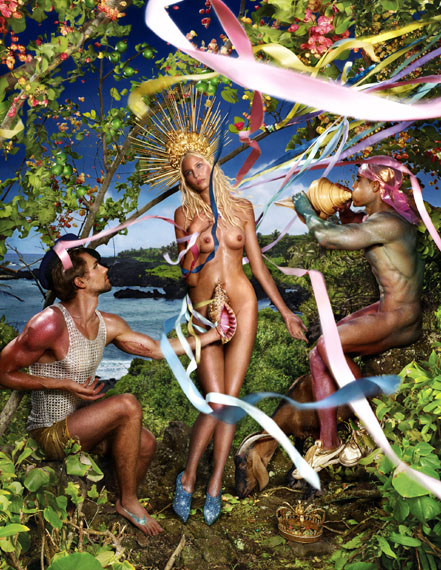
© David LaChapelle
David LaChapelle »
ONCE IN THE GARDEN
Exhibition: 2 Jun – 14 Sep 2014
Sun 1 Jun 17:00

© David LaChapelle
DAVID LACHAPELLE
"ONCE IN THE GARDEN"
Exhibition: 2 June – 14 July, 2014
Opening: Sunday, 1 June, 2014 at 5pm, in the presence of David LaChapelle
During the past three decades, David LaChapelle has created an extraordinary and unmistakeable oeuvre. He has worked with innumerable pop and film stars, and his powerful, provocative, humorous, glamorous, but also surreal and usually extremely colourful works have had a lasting influence on the world of photography and the aesthetics of the visual realm.
The gallery OstLicht presents the exhibition DAVID LACHAPELLE. ONCE IN THE GARDEN, featuring well-known icons of the last twenty years like Amanda Lepore: Addicted to Diamonds, Celebrity Gleam and Amanda as Andy Warhol’s Liz Taylor alongside three of his latest groups of works: Earth Laughs in Flowers, Gas and Land Scape.
Through his exploration of subjects like spirituality and religion, personality cult and physicalness, and by questioning social norms of gender and sexuality, David LaChapelle has managed to influence public awareness. He is not a photographer in the classical sense – rather, he is an image-maker, a storyteller. His visual world is inspired by widely divergent sources like pop culture, the baroque and renaissance world, art history, movies, pornography and even the Bible. David LaChapelle is a master of posing existential questions by utilising commonplace props of the consumer world to create hyper-real settings featuring gleaming and perfect bodies, and by creating an almost bizarre tension between alienation and attraction. Nature as the foundation of our being, confronting each of us in our nakedness, is present as a formative element in the artist’s recent work.
In the series Earth Laughs in Flowers (2008-2011) LaChapelle deals with the transience of life and beauty, borrowing from floral still lifes of the baroque era. In the realm of this Vanitas imagery, plants, fruits and objects testify to the vanity and finite nature of life. These traditional emblems, however, are combined by the artist with objects of daily life that are only noticed at second glance: burning cigarettes, old mobile phones, electronic appliances or plastic bottles serve as modern metaphors of transience in our fast-paced throw-away society.
In his most recent series, Gas and Land Scape, LaChapelle examines global oil production and its infrastructure, which is anything but sustainable. The photographs show gas stations and refineries in lighting settings that vary between kitschy and eerily surreal. However, these are not real buildings, but true-to-scale models made from recycled materials, e.g. egg cartons, computer motherboards, tea canisters, curlers, straws and other recyclable products manufactured from crude oil. In elaborate stagings, LaChapelle photographed these models in the rain forest in Maui (Gas Stations), in the desert and along the Californian coastline (Refineries). This is also an enigmatic commentary by which LaChapelle wants to inspire the viewer’s self-critical reflection about the relentless exploitation of our planet: “These buildings are artefacts of a fallen civilization,” he told the magazine AD in an interview. “If some future archaeologist were to uncover a gas station, like our archaeologists uncover Incan temples, that would be an indicator of what made this civilization rise and fall.”
Once in the Garden, finally, is David LaChapelle’s most recent work and is exhibited as part of the show. Not only did it inspire the title of the OstLicht exhibition, but it is also the title image of the 2014 Life Ball. The diptych makes LaChapelle’s grounding in art history particularly apparent. Motifs like the pink fountain of life and the reclining youth with a fantasy head are strongly reminiscent of Hieronymus Bosch’s The Garden of Earthly Delights (ca. 1500). In his own version of a surreal paradisiacal garden, LaChapelle stages the transgender model Carmen Carrera, giving a strong voice to an issue close to his heart: that love knows no gender boundaries.
Furthermore, Self Portrait as House, presumably LaChapelle’s most personal work, is shown for the first time in Europe at OstLicht.
As a kick-off to the exhibition and the Life Ball a poster campaign in cooperation with Gewista with the images "Once in the Garden (1)" and "Once in the Garden (2)" will take place in public space starting May 12.
Five percent of the net artwork sales profit will be donated to AIDS LIFE.
David LaChapelle was born in Connecticut in 1968. He studied fine arts at the North Carolina School of the Arts. In the mid-1980s he moved to New York. Andy Warhol discovered LaChapelle shortly thereafter at New York’s legendary Studio 54. LaChapelle began taking photographs for Warhol’s magazine Interview, and was soon also commissioned by Rolling Stone, Italian Vogue, French Vogue, GQ and Vanity Fair. His photographic works have been shown at many important museums and galleries around the world.
The exhibition is accompanied by a catalogue edited by Peter Coeln and Reiner Opoku and published by Brandstätter Verlag. It may be purchased for € 19.90.�

© David LaChapelle
DAVID LACHAPELLE
"ONCE IN THE GARDEN"
Ausstellung: 2. Juni – 14. Juli 2014
Eröffnung: Sonntag, 1. Juni 2014, 17 Uhr, in Anwesenheit von David LaChapelle
Vortrag: David LaChapelle: Montag, 2. Juni, 19 h
David LaChapelle hat in den vergangenen drei Jahrzehnten ein außergewöhnliches und unverkennbares Werk geschaffen. Er hat mit unzähligen Pop- und Filmstars gearbeitet und mit seinen kraftvollen, provokanten, humorvollen, glamourösen aber auch surrealen und meist knallbunten Arbeiten die Welt der Fotografie und die Ästhetik der Bildwelt nachhaltig geprägt.
Die Galerie OstLicht präsentiert in der Ausstellung DAVID LACHAPELLE. ONCE IN THE GARDEN neben bekannten Ikonen aus den letzten zwanzig Jahren, wie „Amanda Lepore: Addicted to Diamonds“, „Celebrity Gleam“ oder „Amanda As Andy Warhol’s Liz Taylor“, drei seiner neuesten Werkgruppen: „Earth Laughs in Flowers“, „Gas“ und „Land Scape“.
Durch seine Auseinandersetzung mit Themen wie Spiritualität und Religion, Personenkult und Körperlichkeit und mit der Hinterfragung gesellschaftlicher Normen von Geschlecht und Sexualität gelang es David LaChapelle, das öffentliche Bewusstsein zu beeinflussen. Er ist kein Fotograf im klassischen Sinn, er ist vielmehr ein Bildermacher, ein Geschichtenerzähler. Seine Bildwelt inspiriert sich dabei an unterschiedlichsten Quellen wie Popkultur, Barock, Renaissance, Kunstgeschichte, Kino, Pornographie und sogar an der Bibel. David LaChapelle versteht es mit Versatzstücken der Konsumwelt zwischen glänzenden und makellosen Körpern in hyperrealen Settings existentielle Fragen aufzuwerfen, in dem er eine geradezu bizarre Spannung zwischen Entfremdung und Anziehung erzeugt. Die Natur als Grundlage unseres Seins, der wir alle gleichermaßen nackt gegenüberstehen, ist in den neueren Werken des Künstlers als bildprägendes Element präsent.
In der Serie „Earth Laughs in Flowers“ (2008-2011) befasst sich LaChapelle mit der Vergänglichkeit des Lebens und der Schönheit. Er nimmt dabei Anleihen an Blumenstillleben des Barock. Im Sinne der Vanitas-Darstellungen zeugen Pflanzen, Früchte und Objekte von der Eitelkeit und der Endlichkeit des Lebens. Die tradierten Sinnbilder kombiniert und bricht er jedoch mit Objekten des täglichen Lebens, die erst auf den zweiten Blick ins Auge stechen: Brennende Zigaretten, alte Handys, Elektrogeräte oder Plastikflaschen dienen ihm als moderne Metaphern der Vergänglichkeit in unserer schnelllebigen Wegwerf-Gesellschaft.
Mit seinen jüngsten Serien „Gas“ und „Land Scape“ blickt LaChapelle auf die globale Ölproduktion und deren Infrastruktur, die alles andere als nachhaltig ist. Die Fotografien zeigen Tankstellen und Raffinerien in kitschigen bis unheimlich surrealen Lichtsettings. Es handelt sich jedoch nicht um reale Gebäude, sondern um maßstabgetreue Modelle aus recycelten Materialien, wie Eierkartons, Motherboards von Computern, Tee-Kanistern, Lockenwicklern, Strohhalmen und anderen wiederverwertbaren Produkten auf Erdölbasis. In aufwendigen Inszenierungen fotografierte LaChapelle diese Modelle im Regenwald von Maui (Gas Stations), in der Wüste und entlang der Küste Kaliforniens (Refineries). Es ist auch ein hintergründiger Kommentar, mit dem LaChapelle den Betrachter zu einer selbstkritischen Reflektion über die unerbittliche Ausbeutung unseres Planeten anregen möchte: „Diese Gebäude sind die Artefakte einer versunkenen Zivilisation“, sagte er dazu in einem Interview mit dem Magazin AD. „Wenn zukünftige Archäologen eine Tankstelle ausgraben werden, so wie unsere Archäologen einen Inka-Tempel ausgraben, wird das ein Indikator dafür sein, was Aufstieg und Fall unserer Zivilisation verantwortet hat.“
Mit „Once in the Garden“ wird schließlich David LaChapelles neueste Arbeit gezeigt. Sie ist nicht nur titelgebend für die OstLicht-Ausstellung, sondern auch das Sujet des Life Ball 2014. LaChapelles starker Bezug zur Kunstgeschichte wird in dem Diptychon besonders deutlich. Motive wie der rosafarbenen Lebensbrunnen und der liegende Jüngling mit fantastischem Kopf sind aus Hieronymus Boschs „Der Garten der Lüste“ (um 1500) entlehnt. In seiner Version eines surrealen paradiesischen Gartens inszeniert LaChapelle das Transgender-Modell Carmen Carrera und gibt dem ihm wichtigen Anliegen, dass Liebe keine Geschlechtergrenzen kennt, starken Ausdruck. Weiters ist LaChapelles wohl persönlichstes Werk „Self Portrait As House” im OstLicht zum ersten Mal in Europa ausgestellt.
Als Kick-off zur Ausstellung und des Life Ball findet ab dem 12. Mai in Kooperation mit der Gewista eine Plakataktion mit den Sujets „Once in the Garden (1)“ und „Once in the Garden (2)“ im öffentlichen Raum statt.
Fünf Prozent des Nettoverkaufserlöses der Werke von David LaChapelle kommen AIDS LIFE zu Gute.
David LaChapelle wurde 1968 in Connecticut geboren. Er studierte Kunst an der North Carolina School of the Arts. Mitte der 1980er-Jahre übersiedelte er nach New York. Andy Warhol entdeckte LaChapelle wenig später im legendären New Yorker Studio 54. LaChapelle begann für Warhols Zeitschrift Interview zu fotografieren und bald auch für Rolling Stone, Italien Vogue, French Vogue, GQ und Vanity Fair. Mit seiner fotografischen Arbeit ist er in vielen bedeutenden Museen und Galerien auf der ganzen Welt präsent.
Zur Ausstellung erscheint ein Katalog herausgegeben von Peter Coeln und Reiner Opoku, im Brandstätter Verlag. Erhältlich um Euro 19,90.�

© David LaChapelle

© David LaChapelle
